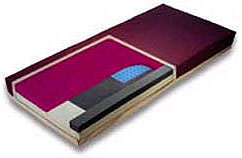Archives
Computer modeling applied to mattress design
By LORRAINE O.W. STINEBISER
Reporter Contributor
A team of engineers from UB's New York State Center for Engineering Design and Industrial Innovation (NYSCEDII) and the Department of Mechanical and Aerospace Engineering in the School of Engineering and Applied Sciences is applying its expertise in virtual prototyping and simulation to mattresses.

Using virtual prototyping and simulation, UB researchers have developed a new type of mattress designed to prevent pressure ulcers.
These are not the typical household mattresses, but rather specialty beds developed by Gaymar Industries, Inc. of Orchard Park and designed to prevent pressure ulcers.
The UB team worked with Gaymar scientists and engineers to model the contact between the patient and the mattress to aid in the development, characterization and improvement of the design and material in Gaymar's Isoflex® mattress.
The partnership with UB proved to be a critical factor recently when Gaymar was bidding on a large contract. Using computer modeling that showed the unique loading and column bucking design of Isoflex® mattress cells, Gaymar and its strategic business partner won a bid worth more than $1 million.
"Not only were we able to demonstrate that the company was getting a high-tech mattress constructed of unique material, but we also could demonstrate the science of how it performed," said Thomas Stewart, president of Gaymar.
Abani Patra, associate professor of mechanical and aerospace engineering, headed up the UB research team, which also included Kenneth English, deputy director of NYSCEDII; Kevin Hulme, research associate with NYSCEDII; Mark Lukowski, lab equipment designer in the Department of Mechanical and Aerospace Engineering; and several engineering graduate students.
The multiphase project was supported by the UB Center for Advanced Biomedical and Bioengineering Technology (CAT), a program of the New York State Office of Science, Technology and Academic Research (NYSTAR).
Using finite-element analysis, the team built a computer model to simulate a human lying on the mattress. Numerous designs and materials were evaluated using this simulation tool. At Gaymar, a physical prototype was tested and measured against the virtual prototype developed in the simulation. Gaymar currently is evaluating the manufacturability and cost of the proposed new design.
"Our partnership with UB allows us to employ the latest in computer modeling to continually refine our product and provide our customers with the best possible mattress to prevent pressure ulcers," noted Stewart. Gaymar and UB are continuing with its collaborative research to further refine materials and designs for the Isoflex brand.
"The UB and Gaymar project is a good example of how the Center for Advanced Technology program can help New York State companies gain a competitive edge," said William M. Mihalko, UB CAT executive director. "The development and subsequent commercialization of this product will have a positive economic impact on the region and the state."
UB CAT is administered by the UB Office of Science, Technology Transfer and Economic Outreach. It provides gap funding to support industry-university collaborative projects that promote the development and commercialization of biomedical and bioengineering research that creates new jobs and opportunities for New York State companies.
